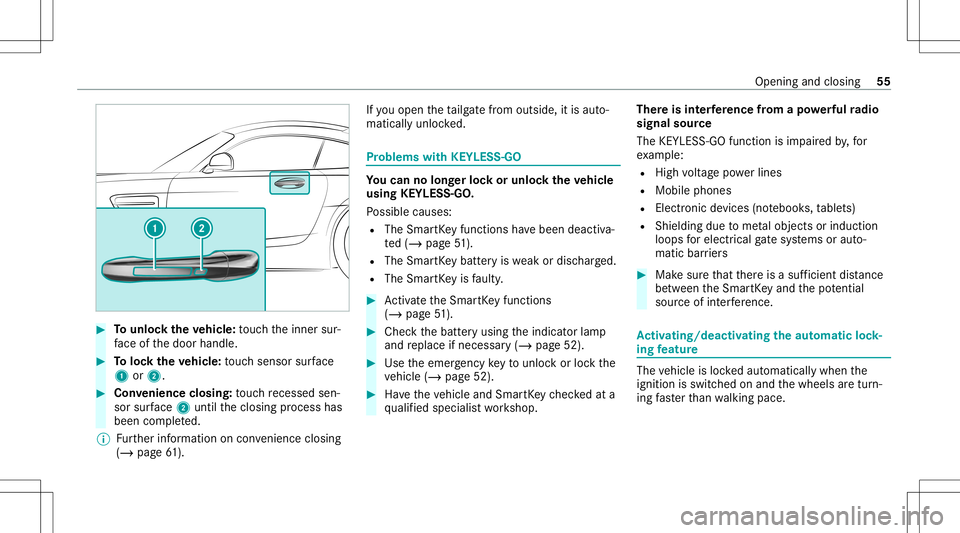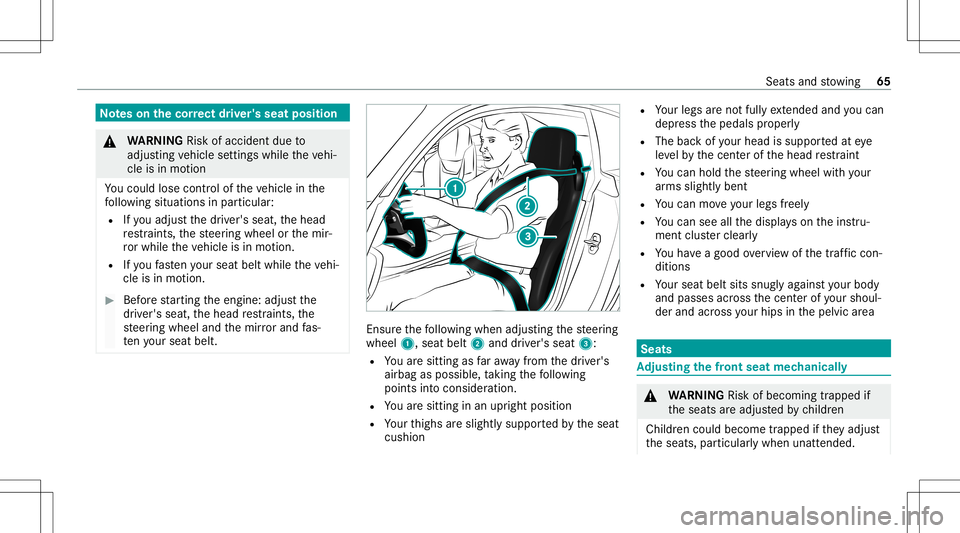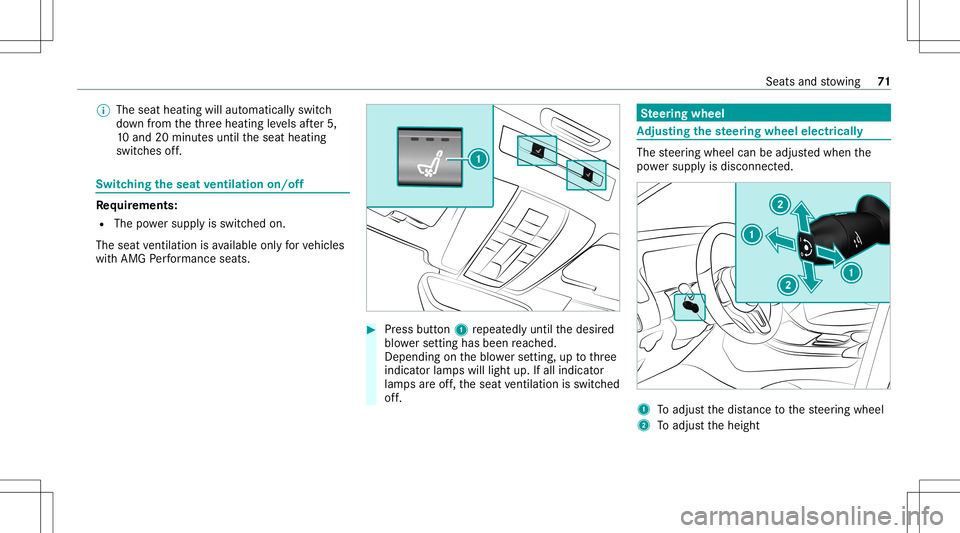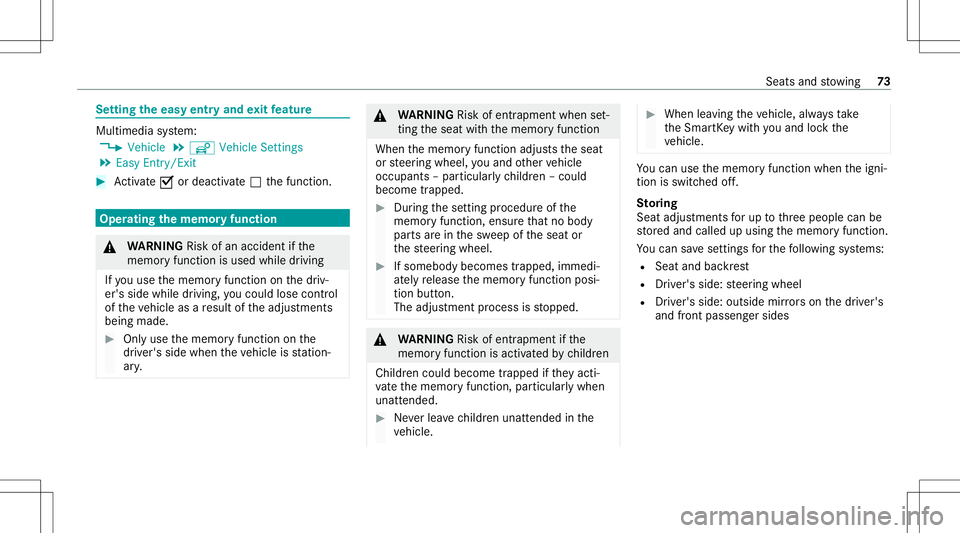2021 MERCEDES-BENZ GT COUPE wheel
[x] Cancel search: wheelPage 57 of 422

#
Tounlo cktheve hicl e:touc hth einner sur‐
fa ce ofthedoor handle. #
Toloc kth eve hicl e:touc hsen sor surface
1 or2. #
Convenience closing:touc hre cess edsen‐
sor surface 2untilth eclosing process has
been completed.
% Further information oncon venie nce closing
(/ page 61). If
yo uopen theta ilg atefrom outs ide,itis aut o‐
matic allyunloc ked. Pr
oblems withKEYLE SS-GO Yo
ucan nolon gerlo ck orunloc kth eve hicl e
using KEYLESS-GO .
Po ssible causes:
R The Smar tKey functions have been deactiv a‐
te d(/ page51 ).
R The Smar tKey batt eryis we ak ordisc harged.
R The Smar tKey isfaulty . #
Activateth eSmar tKey functions
(/ page51 ). #
Chec kth ebatt eryusing theindicat orlam p
and replace ifnec essar y(/ page52). #
Use theemer gency keyto unlo ckorloc kth e
ve hicle (/page52). #
Have theve hicle andSmar tKey checkedat a
qu alif ied spec ialistwo rkshop. Ther
eis int erfere nce from apo we rful radio
sig nal source
The KEYLESS-G Ofuncti onisim pa ired by,fo r
ex am ple:
R Highvo ltag epo we rlines
R Mobi lephones
R Electr onicdevices (notebook s,table ts)
R Shielding duetome talobje ctsor induc tion
loops forelectr icalgate systems oraut o‐
matic barrier s #
Mak esur eth at ther eis asuf ficie ntdist anc e
be tween theSmar tKey and thepo tentia l
sou rceof interfere nce. Ac
tiv atin g/deac tivatin gthe automati clo ck ‐
ing featur e The
vehicle isloc kedaut omatic allywhen the
ignit ionisswitc hedonand thewheels aretur n‐
ing faster than walkin gpace. Open
ingand closing 55
Page 67 of 422

No
teson thecor rect driver' sseat position &
WARNIN GRisk ofacci dent dueto
adjus tingve hicle settin gswhile theve hi‐
cle isin mo tion
Yo uco uld lose contro lof theve hicle inthe
fo llo wing situat ionsinpar ticular :
R Ifyo uadj ustth edr iver's seat, thehead
re stra int s,thesteer ing wheel orthemir‐
ro rwhi letheve hicle isin mo tion.
R Ifyo ufa sten your seat beltwhile theve hi‐
cle isin mo tion. #
Beforest ar tin gth eengine: adjustth e
dr iver's seat, thehead restra int s,the
st eer ing wheel andthemir rorand fas‐
te nyo ur seat belt. En
sur eth efo llo wing when adjustingth esteer ing
wheel 1,seat belt2and driver's seat 3:
R Youar esit tin gas faraw ay from thedr iver's
airbag aspossible, taking thefo llo wing
point sint ocon sider ation .
R Youar esit tin gin an upr ight position
R Your thighs areslight lysuppor tedby theseat
cushion R
Your legs areno tfull yex tende dand youcan
depr essthepedals proper ly
R The backof your head issuppo rted ateye
le ve lby thecent erofthehead restra int
R Youcan hold thesteer ing wheel withyo ur
ar ms sligh tly ben t
R Youcan moveyour legs freel y
R Youcan seeallthedispla yson theins tru‐
ment clusterclea rly
R Youha ve agood overvie wof thetra ffic con ‐
dition s
R Your seat beltsitssn ug lyag ains tyo ur body
and pass esacr oss thecent erofyour sho ul‐
der and across your hips inthepelvic area Seats
Ad
jus tingthe fron tse at mec hanicall y &
WARNIN GRisk ofbeco ming trap ped if
th eseats areadjus tedby childr en
Childr encould becom etrapped ifth ey adjus t
th eseats, particular lywhen unattende d. Sea
tsand stow ing 65
Page 68 of 422

#
When leaving theve hicle, alwaysta ke
th eSmar tKey wit hyo uand lockth e
ve hicle. #
Neverlea vechildr enunat tende din the
ve hicle. &
WARNIN GRisk ofbeco ming trap ped
whe nad jus ting theseat
When youadj usta seat ,yo uor other vehicle
occupants couldbecome trapped, e.g.onthe
seat guide rail. #
When adjustingaseat, makesur eth at
no onehas anypar tof their body within
th esw eep oftheseat. Obser
vethesaf etyno teson "Airbags" and"Chil‐
dr en intheve hicle". &
WARNIN GRisk ofacci dent dueto the
dr iver's seat notbeing engaged
The driver's seat maymo veune xpectedl y
while theve hicle isin mo tion. This
could cause youto lose control of the
ve hicle. #
Alw aysmak esur eth at thedr iver's seat
is eng aged bef orest ar tin gth eve hicle. &
WARNIN GRisk ofacci dent dueto
adjus tingve hicle settin gswhile theve hi‐
cle isin mo tion
Yo uco uld lose contro lof theve hicle inthe
fo llo wing situat ionsinpar ticular :
R Ifyo uadj ustth edr iver's seat, thehead
re stra int s,thesteer ing wheel orthemir‐
ro rwhi letheve hicle isin mo tion.
R Ifyo ufa sten your seat beltwhile theve hi‐
cle isin mo tion. #
Beforest ar tin gth eengine: adjustth e
dr iver's seat, thehead restra int s,the
st eer ing wheel andthemir rorand fas‐
te nyo ur seat belt. &
WARNIN GRisk ofbeco ming trap ped if
th eseat height isadjus tedcar elessl y
If yo uadj ustth eseat height carelessly ,yo u
or other vehicle occupants couldbetrapped
and ther eb yinjur ed.
Childr eninpar ticular couldacciden tally
pr ess theelectr icalseat adjus tmentbutt ons
and become trapped. #
While moving theseats, makesur eth at
han dsorother body partsdo notget
und ertheleve rasse mbly oftheseat
adjus tmentsy stem. &
WARNIN GRisk ofinju rydue tohead
re stra int sno tbeing installed orbeing
adjus tedincor rectl y
If hea dre stra int sha ve notbe en installed or
ha ve notbe en adjus tedcor rectly ,th er eis an
incr eased risk ofinjur yin thehead andneck
ar ea, e.g. intheev ent ofan acciden tor when
br aking. 66
Seats andstow ing
Page 71 of 422

#
Toadjus tth eseat sidebolsters of the
seat cushion:press butt on1 (nar rowe r)or
2 (wider). #
Toadjus tth eseat sidebolsters of the
seat backres t:press butt on3 (nar rower)
or 4 (wider). Head
restra ints Ad
jus tingthe head restra ints &
WARNIN GRisk ofacci dent dueto
adjus tingve hicle settin gswhile theve hi‐
cle isin mo tion
Yo uco uld lose contro lof theve hicle inthe
fo llo wing situat ionsinpar ticular :
R Ifyo uadj ustth edr iver's seat, thehead
re stra int s,thesteer ing wheel orthemir‐
ro rwhi letheve hicle isin mo tion.
R Ifyo ufa sten your seat beltwhile theve hi‐
cle isin mo tion. #
Beforest ar tin gth eengine: adjustth e
dr iver's seat, thehead restra int s,the
st eer ing wheel andthemir rorand fas‐
te nyo ur seat belt. &
WARNIN GRisk ofinju rydue tohead
re stra int sno tbeing installed orbeing
adjus tedincor rectl y
If hea dre stra int sha ve notbe en installed or
ha ve notbe en adjus tedcor rectly ,th er eis an
incr eased risk ofinjur yin thehead andneck
ar ea, e.g. intheev ent ofan acciden tor when
br aking. #
Alw aysdr ive wit hth ehead restra int s
ins talled. #
Beforedr ivin gof f,mak esur efo rev ery
ve hicle occupant that thecent erofthe
head restra int suppor tsthebac kof the
head atabout eyeleve l. Seat
sand stow ing 69
Page 73 of 422

%
The seat heating willautomaticall yswitc h
do wn from theth re eheating leve ls afte r5,
10 and 20min utes unt ilth eseat heating
switc hesoff. Switc
hingtheseat ventilat ionon/of f Re
quirement s:
R The powe rsupp lyis switc hedon.
The seat ventil ation isavailable onlyforve hicles
wit hAMG Perfor mance seats. #
Press butt on1 repeat edly until thedesir ed
blo werse tting hasbeen reac hed.
De pen dingon theblo werse tting, uptothre e
indic ator lam pswill light up.Ifall indic ator
lam psareof f,th eseat ventil ation issw itched
of f. Ste
ering wheel Ad
jus tingthe steer ing wheel electrically The
steer ing wheel canbeadjus tedwhen the
po we rsupp lyis disco nnect ed. 1
Toadjus tth edis tance tothesteer ing wheel
2 Toadjus tth eheight Seats
andstow ing 71
Page 74 of 422

#
Save these ttings withth ememor yfunc tion
(/ page73 ). Easy
entryand exitfeatur e Usi
ngtheeasy entryand exitfeatur e &
WARNIN GRisk ofacci dent whenpu lling
aw ay dur ing theadjus tmentpr ocess for
th eeasy exitfeatur e
Yo uco uld lose contro lof theve hicle. #
Alw ayswa itunt ilth eadjus tmentpr oc‐
ess iscom pletebef orepulling away. &
WARNIN GRisk ofbeco ming trap ped
du ring adjus tment oftheeasy entryand
ex itfeatur e
Yo uand other vehicle occupants could
become trapped. #
Ensur eth at no onehas anybody parts
in thera ng eof mo vement ofthesteer‐
ing wheel. #
Movetheadjus tmentle ve rof thesteer‐
ing wheel ifth er eis arisk ofbecoming
tr apped bythesteer ing wheel.
The adjus tmentpr ocess isstopped. &
WARNIN GRisk ofbeco ming trap ped
du ring acti vatio nof theeasy entryand
ex itfeatur eby childr en
If ch ildr enact ivat eth eeasy entryand exit
fe atur e,they can beco metrap ped ,pa rticu‐
lar lywhen unattende d. #
Neverlea vechildr enunat tende din the
ve hicle. #
When leaving theve hicle, alwaysta ke
th eSmar tKey wit hyo uand lockth e
ve hicle. Ve
hicl eswith memor yfuncti on:youcan stop
th eadjus tmentpr ocess bypressing oneofthe
memor yfunction position switc hes. If
th eeasy entryand exitfeatur eis act ive, the
st eer ing wheel willmoveupw ards ortowa rdsth e
dashboar dwhen:
R Youswit chtheignition off.
R Youopen thedr iver's door .
% The steer ing wheel willmoveupw ards and
to wa rdsth edashboar donl yif it has not
alr eady reac hed thesteer ing limit ation.
The steer ing wheel willmovebac kto thelas t
dr ive position when:
R Youclo sethedr iver's door withth eignition
switc hedon.
R Youpr ess thest ar t/ stop butt ononce.
The lastdr ive position willbesave dwhen:
R Youswit chtheignition off.
R Yousa ve these tting withth ememor yfunc ‐
tion .
If yo upr ess oneof thememor yfunc tion memor y
position switches,theadjus tmentpr ocess will
be stopped. 72
Seatsand stow ing
Page 75 of 422

Se
tting theeasy entryand exitfeatur e Mul
timedi asy stem:
4 Vehicle 5
î Vehicle Setting s
5 Easy Entry/E xit #
Activate0073 ordeacti vate 0053 thefunc tion. Oper
ating themem oryfun ction &
WARNIN GRisk ofan acci dent ifth e
memor yfunction isused whiledriving
If yo uuse thememor yfunc tion onthedr iv‐
er's side while driving, youco uld lose contro l
of theve hicle asare sult oftheadjus tments
being made. #
Onlyuse thememor yfunc tion onthe
dr iver's side when theve hicle isstatio n‐
ar y. &
WARNIN GRisk ofentr apment whense t‐
ting theseat withth ememor yfunc tion
When thememor yfunc tion adjus tstheseat
or steer ing wheel, youand other vehicle
occupants –par ticular lych ildr en–could
becom etrapped. #
Dur ing these tting procedur eof the
memor yfunction, ensureth at no body
par tsarein thesw eep oftheseat or
th esteer ing wheel. #
Ifsomebody becomestrapped, immedi‐
at elyre lease thememor yfunc tion posi‐
tion button.
The adjus tmentpr ocess isstopped. &
WARNIN GRisk ofentr apment ifth e
memor yfunction isactiv ated bychildr en
Childr encould becom etrapped ifth ey act i‐
va te thememor yfunc tion,par ticular lywhen
unatt ended. #
Neverlea vechildr enunat tende din the
ve hicle. #
When leaving theve hicle, alwaysta ke
th eSmar tKey wit hyo uand lockth e
ve hicle. Yo
ucan usethememor yfunc tion when theigni‐
tion isswitc hedoff.
St oring
Seat adjus tment sfo rup tothre epeople canbe
st or ed and called upusing thememor yfunc tion.
Yo ucan save settin gsforth efo llo wing systems:
R Seat andbackres t
R Driver's side: steer ing wheel
R Driver's side: outside mirrors on thedr iver's
and front passeng ersides Seats
andstow ing 73
Page 88 of 422

#
Setth ewiper bladeatan ang le. #
Pull thewiper bladeoutoftheholder onthe
wiper arm inthedir ect ion ofthear ro w.
Ins tallin gth ewiper blades #
Push thene wwiper bladeintoth eholder on
th ewiper arm agains tth edir ect ion ofthe
ar row . #
Turn thewiper bladeparallel tothewiper
ar m. #
Foldthewiper arm ont oth ewindshield. Mir
rors Oper
ating theout side mirrors &
WARNIN GRisk ofacci dent dueto
adjus tingve hicle settin gswhile theve hi‐
cle isin mo tion
Yo uco uld lose contro lof theve hicle inthe
fo llo wing situat ionsinpar ticular :
R Ifyo uadj ustth edr iver's seat, thehead
re stra int s,thesteer ing wheel orthemir‐
ro rwhi letheve hicle isin mo tion.
R Ifyo ufa sten your seat beltwhile theve hi‐
cle isin mo tion. #
Beforest ar tin gth eengine: adjustth e
dr iver's seat, thehead restra int s,the
st eer ing wheel andthemir rorand fas‐
te nyo ur seat belt. &
WARNIN GRisk ofacci dent dueto mis‐
judgment ofdis tance when using the
fr ont-passe nger mir ror
The outside mirroron thefront passeng er
side reflect sobjec tson asmaller scale. #
Ther efor e, alw ayslook over your sho ul‐
der inorder toensur eth at youar e
aw areof theactual distance betwee n
yo uand thero ad user sdr ivin gbehin d
yo u. 86
Lightand visibilit y